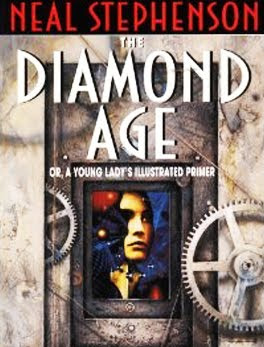 The only thing more epic than the post-cyberpunk novel The Diamond Age: Or, A Young Lady's Illustrated Primer by Neal Stephenson, is the path it is taking (or perhaps not taking) to become a three-part, six-hour television miniseries.
The only thing more epic than the post-cyberpunk novel The Diamond Age: Or, A Young Lady's Illustrated Primer by Neal Stephenson, is the path it is taking (or perhaps not taking) to become a three-part, six-hour television miniseries.The on and off again project has trudged along. It was originally green lighted by SyFy (then called Sci Fi Channel) in 2007 and awarded to George Clooney and Grant Heslov's Smoke House Productions. It was then stalled during the writers strike in 2007-2008.
In 2009, The Diamond Age miniseries resurfaced when Variety reported Zoë Green had been tapped to write the script, just a few weeks before Clooney and Heslov made the move to Sony Pictures Entertainment. The most recent update came last year when several publications reported Green was still tackling the script for the miniseries during negotiations to pen a Disney live-action film featuring gargoyles.
Why The Promise Of A Miniseries Seems Alluring.
The Diamond Age is principally about an abused and disadvantaged girl, Nell, growing up in a lowland slum belt on a world overly reliant on nanotechnology and without nations in the not so distant future. In the place of nations, the world has developed tribes. Most are globalized, maintaining enclaves all over the world.
Nell's life begins to change after her brother steals an illegal copy of an interactive book, A Young Lady's Illustrated Primer (etc.), that engineer and designer John Percival Hackworth had intended for his daughter. Hackworth made the copy after working on the original book, which was meant for Lord Finkle-McGraw's granddaughter.
 The importance of the primers is that they are meant to teach the girls subversive thinking, enabling them to pursue more interesting and free-spirited lives than the rigid protocols and societal rules established by their particular tribe. As a technology, the primer is leap forward in that it not only writes each girl into stories but also adapts stories based on the situations they face in everyday life, even giving them the skill sets they need to survive.
The importance of the primers is that they are meant to teach the girls subversive thinking, enabling them to pursue more interesting and free-spirited lives than the rigid protocols and societal rules established by their particular tribe. As a technology, the primer is leap forward in that it not only writes each girl into stories but also adapts stories based on the situations they face in everyday life, even giving them the skill sets they need to survive. As a story, author Stephenson weaves the novel primarily through the point of view of Nell, in the real world and within the fable-laced primer, and the point of view of Hackworth. Several other characters share the spotlight from time to time. Watching Nell grow up and apply the interruptive counterpoints offered by the primer to real life is the diamond within the mine.
Through it all, however, Stephenson creates a richly textured and deeply layered story. And even though the future is immersed in technologies, it focuses on the social science over hard science. Stephenson invests as much time in detailing societal connections and cultural relationships, going to great lengths to help his readers understand the varied cultural interactions. One exception are the Drummers, who employ technology to create a hive-like mind and bizarre existence.
About Author Neal Stephenson.
 A Seattle-based American writer, Stephenson is known for his works of speculative fiction. He wrote his first novel, The Big U, in 1984, three years after graduating from Boston University with a degree in geography and a minor in physics. His most recent book, Anathem, received nominations for the British Science Fiction Association, Hugo, and Clarke Awards in 2008.
A Seattle-based American writer, Stephenson is known for his works of speculative fiction. He wrote his first novel, The Big U, in 1984, three years after graduating from Boston University with a degree in geography and a minor in physics. His most recent book, Anathem, received nominations for the British Science Fiction Association, Hugo, and Clarke Awards in 2008. Recently, Stephenson teamed with Greg Bear to cowrite a subscription-based historical novel about Genghis Khan conquests. They are among a growing number of writers looking to break away from traditional publishing. The story, The Mongoliad, goes further with a rich first step in interactive and participatory storytelling.
The Diamond Age by Neal Stephenson Weighs 6.2 On The Liquid Hip Richter Scale.
The almost 500-page novel reads as if it was much larger, making it especially easy to become lost within the nuances of the world Stephenson created. Sometimes, it may even leave readers searching for a plot thread to keep from drowning in it all. Eventually those loosely woven strands do come together, but without the benefit of tightening or tidy resolutions, which is characteristic of the author's work.
Despite the sheer weight of the pallet, there are moments within The Diamond Age that are unforgettably interesting, touching, and tirelessly engaging. While the first half of the book is effortlessly greater than the last half (a better split is 70-30), chalk up the change in temperament to the increasing oddness of Hackworth's storyline and the shift from the psychological aspects of Nell's coming of age story to the greater purview of a tribe she leads.
The Diamond Age: Or, a Young Lady's Illustrated Primer (Bantam Spectra Book) is available on Amazon. The Diamond Age is also available as an unabridged audiobook on iTunes.
Read by Jennifer Wiltsie (18 hours, 33 minutes), have a listen to the preview before purchasing it. Wiltsie feels perfectly cast throughout much of the book, but completely miscast in others. It might not be her narration, but a technical weakness in the writing, particularly transitions that cause some rough breakage.
![Liquid [Hip]](https://blogger.googleusercontent.com/img/b/R29vZ2xl/AVvXsEjAFBQPqS7J0-rrttNoRYSsuwIePPZf4Nq6sqDioK1zzVQXJIQXKzq_NVNI4n6h3inuRQFBKOcJeZeSufkdHHIOxbSWyBjTjTxgKEQGyPzdwvkEEeECh4bI5YEGk4RWGUINSd7vulPQsCA/s1600-r/liquidhip.jpg)